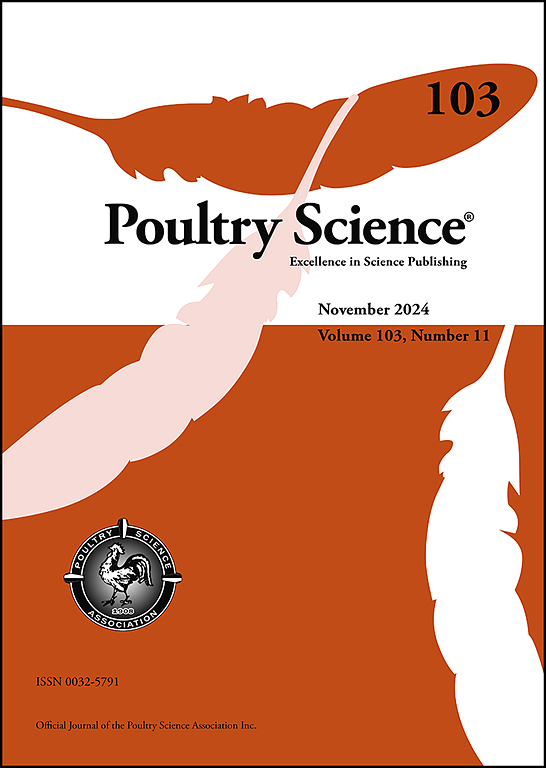Ecological prevalence and genomic characterization of Salmonella isolated from selected poultry farms in Jiangxi province, China
IF 3.8
1区 农林科学
Q1 AGRICULTURE, DAIRY & ANIMAL SCIENCE
引用次数: 0
Abstract
Non-typhoidal Salmonella (NTS), particularly antimicrobial-resistant serovars, remains the major source of foodborne bacterial illnesses. Raw chicken is the leading cause of human salmonellosis. In this study, we evaluated the prevalence, antimicrobial resistance profiles, and genomic features of 143/1,800 (7.94%) Salmonella strains isolated from poultry farms in five major regions of Jiangxi province, China, between 2022 and 2023 using Whole genome sequencing (WGS). Among Salmonella isolates, the most common serovars were Infantis (ST32) and Enteritidis (ST11). Resistance to amoxicillin and tetracycline was the most prevalent, with 60.84% of Salmonella isolates exhibiting a multi-drug resistance (MDR) pattern. The detection of antimicrobial-resistant genes (ARGs) examined was aligned with the resistant phenotypes found. A total of 61 ARGs were identified, with aph(3′)-Ia, qnrS1, aph(3′')-Ib, and tetA being the prominent ARGs. Furthermore, 24 beta-lactam genes were also identified, including blaTEM, blaSHV, and blaCTX-M. The number of ARGs and the distribution of serovars varied according to the year, farms, and cities. Salmonella isolates carried 13 heavy metal resistance genes (HMRGs) and two biocide resistance genes, with pcoS being the most prevalent. A total of 145 virulence genes and 19 plasmids were found, with serovars Infantis and Enteritidis having the most virulence genes. The high occurrence of MDR Salmonella in this study, particularly carrying numerous mobile genetic elements (MGEs), posed a serious threat to food safety and public health, emphasizing the need to improve poultry farm hygiene to decrease contamination and transmission.
江西省家禽养殖场分离沙门氏菌的生态流行病学及基因组特征分析
非伤寒沙门氏菌(NTS),尤其是抗菌血清型,仍然是食源性细菌性疾病的主要病源。生鸡肉是导致人类沙门氏菌病的主要原因。在这项研究中,我们利用全基因组测序(WGS)技术评估了 2022 年至 2023 年期间从中国江西省五大地区的家禽养殖场分离的 143 株/1800 株(7.94%)沙门氏菌的流行率、抗菌药耐药性特征和基因组特征。在分离的沙门氏菌中,最常见的血清型为Infantis(ST32)和Enteritidis(ST11)。对阿莫西林和四环素的耐药性最为普遍,60.84%的沙门氏菌分离株表现出多重耐药性(MDR)模式。抗菌药耐药基因(ARGs)的检测结果与发现的耐药表型一致。共鉴定出 61 个 ARGs,其中以 aph(3′)-Ia、qnrS1、aph(3′')-Ib 和 tetA 为主要 ARGs。此外,还发现了 24 个β-内酰胺基因,包括 blaTEM、blaSHV 和 blaCTX-M。ARGs的数量和血清型的分布因年份、农场和城市而异。沙门氏菌分离物携带 13 个重金属抗性基因(HMRGs)和 2 个杀菌剂抗性基因,其中 pcoS 最为普遍。共发现 145 个毒力基因和 19 个质粒,其中 Infantis 和 Enteritidis 血清型的毒力基因最多。本研究中出现了大量 MDR 沙门氏菌,尤其是携带大量移动遗传因子 (MGE),这对食品安全和公共卫生构成了严重威胁,强调了改善家禽养殖场卫生以减少污染和传播的必要性。
本文章由计算机程序翻译,如有差异,请以英文原文为准。
求助全文
约1分钟内获得全文
求助全文
来源期刊

Poultry Science
农林科学-奶制品与动物科学
CiteScore
7.60
自引率
15.90%
发文量
0
审稿时长
94 days
期刊介绍:
First self-published in 1921, Poultry Science is an internationally renowned monthly journal, known as the authoritative source for a broad range of poultry information and high-caliber research. The journal plays a pivotal role in the dissemination of preeminent poultry-related knowledge across all disciplines. As of January 2020, Poultry Science will become an Open Access journal with no subscription charges, meaning authors who publish here can make their research immediately, permanently, and freely accessible worldwide while retaining copyright to their work. Papers submitted for publication after October 1, 2019 will be published as Open Access papers.
An international journal, Poultry Science publishes original papers, research notes, symposium papers, and reviews of basic science as applied to poultry. This authoritative source of poultry information is consistently ranked by ISI Impact Factor as one of the top 10 agriculture, dairy and animal science journals to deliver high-caliber research. Currently it is the highest-ranked (by Impact Factor and Eigenfactor) journal dedicated to publishing poultry research. Subject areas include breeding, genetics, education, production, management, environment, health, behavior, welfare, immunology, molecular biology, metabolism, nutrition, physiology, reproduction, processing, and products.
 求助内容:
求助内容: 应助结果提醒方式:
应助结果提醒方式:


